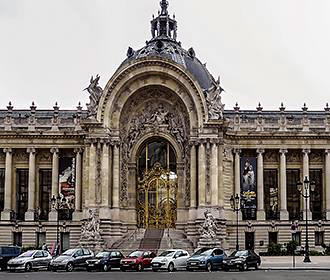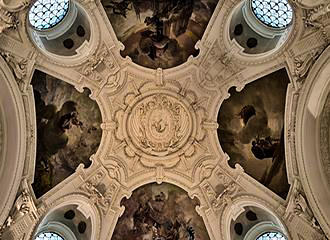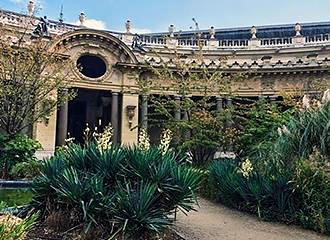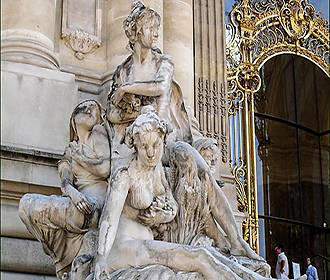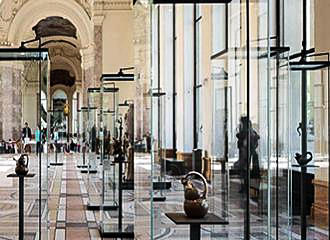Paris Petit Palais history and the building
Constructed for the 1900 World Fair, the Petit Palais combines a blend of traditional and modern architecture, but with the grandeur and dignity of a palace that took over 20 years to complete, yet became another museum in Paris in 1902.
Beginnings of the Petit Palais history
After the success of the 1889 Universal Exhibition, France wanted once again to showcase their supremacy in arts, industry and technology and in 1894, the city of Paris decided to hold a competition to get the best ideas possible.
This led to hundreds of different projects being put forward, including around twenty different proposals that suggested major improvements to the city. Some of these recommended building a major thoroughfare from the Avenue des Champs Elysees to the Esplanade des Invalides, which is now called the Avenue Winston-Churchill, along with building a new bridge over the River Seine, which is now the famous bridge called the Pont Alexandre III.
There were also a few ideas that included building two palatial buildings along this new avenue that was to be constructed, with the proposal of demolishing the Palais de l’Industrie, which was a building that had originally been constructed for the 1855 World Fair.
Because it laid parallel to the Champs Elysees Avenue and obstructed views to Les Invalides, it was deemed in the way for the new Paris development plans and so, the two new palacial buildings to be constructed in its place would became known as the Grand Palais and the Petit Palais.
Now as you can no doubt gather, this was the proposal put forward that impressed the city of Paris the most, and rather than temporary structures like some that were built for previous world fairs, it was decided that these would be permanent buildings that would serve a purpose in the future.
The Grand Palais was to be run by the French State and used for events originally conducted at the Palais de l’Industrie, yet the Petit Palais was to be run by the City of Paris and used as a museum for fine arts.
So another competition was launched in 1896 in order to come up with the designs for both the Grand Palais and the Petit Palais, although it was a difficult project due to design concept constraints, but because of the 15,000 Franc prize for the winner, there were more than 250 different entries submitted for the architectural design of these two buildings.
However, it was eventually decided that the work on the two buildings would be a collective effort, which would be inspired by a few different projects that had been submitted, and for the Grand Palais the task was given to Albert Louvet, Henri Deglane and Albert Thomas.
Yet it was Charles Girault, who was the architect that had the winning design for the Petit Palais, although he had actually been classed as fourth overall in the design competition. Not only was Charles Girault chosen for the construction of the Petit Palais, but he was also to manage the co-ordination of all the major design work for both of these buildings.
The Petit Palais Building
The design of the Petit Palais is based upon a trapezium shape made up of four wings around a semi circular garden that is bordered by a richly decorated peristyle, which is basically a porch with columns, otherwise known as a colonnade.
Charles Girault managed to achieve a blend of traditional and modern architecture that allows the visitors to flow through the building, into the openings on the inner courtyard garden and onto the Jardins des Champs Elysees Gardens.
Yet he also wanted the building to have grandeur like that of an official palace, and the locations of the different areas to be highly decorated were carefully chosen, in order to glorify the City of Paris and celebrate the arts.
Therefore the main focus for the interior design and decoration was to be in areas that the visitors would always see such as the entrance lobbies, the staircase under the cupola and the garden peristyle, and only two main large exhibition areas were to have decorative murals.
However, even though the Petit Palais did open for the 1900 Universelle Exposition in Paris, the Petit Palais did not became a museum until 1902, which is known as the Musee des Beaux-Arts de la Ville de Paris, yet the decorative murals and sculptures were only started in 1903 and took twenty years to complete!
Design Elements of the Petit Palais
There are many different design elements incorporated into the building that were not completed for many years after opening, however, these are just as much a feature of the Musee Petit Palais Museum as the actual exhibits themselves..
The Decorative Murals
For the entrance lobby of this Paris museum, Albert Besnard was given the task of painting four decorative murals, which he named Matter, Thought, Formal Beauty and Mysticism, that took him from 1903 through to 1910 to complete.
The two galleries, which are both 15 metres long have decorative murals that took from 1906 through to 1911 to complete, the first one of which tells the story of the history of Paris from the Battle of Lutetia up to the French Revolution, whereas the second illustrates modern Paris. Above the main galleries there are sixteen plaster busts set into the walls that represent famous artists such as Eugene Delacroix.
There are also painted ceilings in the pavilions that took from 1909 through to 1924 to complete and the North Pavilion has two ceilings that were painted by Ferdinand Humbert, plus there is another painted ceiling in the South Pavilion that was produced by Georges Picard.
The Garden Peristyle
A peristyle is also known as a colonnade or a covered porch with columns, and the garden peristyle at the Petit Palais has a vaulted ceiling with three large sections to it. The vaulted ceiling was the work of Paul Baudouin, who had studied under Puvis de Chavannes and reinvented the art of fresco painting, which had generally been neglected since the Renaissance period.
You will find that the huge vista of vines that Paul Baudouin painted is interspersed with medallions featuring the months of the year, the hours of day and night, and in between the three large sections, these are interspersed with the depictions of the seasons.
The Dutuit Cupola
The cupola, which is located above the beautiful staircase in the south east of the Musee Petit Palais was the last phase of the work and took place after World War I had finished.
This area was named after the Dutuit brothers who provided a substantial bequest of works to the Petit Palais museum, and the painting composition was entrusted to Maurice Denis where it portrays the history of French art, which is illustrated by portraits of artists along with their famous works.
But there are also other design features to discover at the Petit Palais..
The Wrought Iron Work
The architect and designer, Charles Girault, designed the main entrance gate himself, and he received much praise for its elegance but also the craftsmanship. Yet he also created the banisters for the staircases in the rotundas, along with the impressive wrought iron decorations of the peristyle and the balconies.
Mosaics
These luxury floor surfaces were produced by the famous Italian mosaic artist, Giandomenico Facchina, who was also commissioned for mosaics at other famous Paris tourist attractions, such as at the Opera Garnier.
You will be able to discover many different mosaics at the Petit Palais such as on the floors of the galleries, within the wings and on the first floor rotunda, however it did not stop there, as Giandomenico Facchina also produced mosaics with little blocks of marble at the edges of three ponds and at the garden peristyle.
He is also famous for his mosaic decorations at other museums in Paris such as the Musee Grevin waxwork museum, the Musee Carnavalet and the Musee de la Mode de la Ville de Paris, which is also known as the Musee Galliera.
Stained Glass
Stained glass is often thought of just for churches and cathedrals, but at the Petit Palais you will be able to discover four round stained glass windows known as oculi, which are located at the entrance rotunda. These were manufactured in an American style with clear and opal glass, and were produced at the Champigneulle workshops in the Lorraine region of France.
So as you can no doubt tell, rather than just thinking about visiting the Musee Petit Palais otherwise known as the Musee des Beaux-Arts de la Ville de Paris with its fine art collection, there is so much more to discover with the incredible architecture and the ornate impressive decorative design features.
Not forgetting the new additions of an auditorium and the Jardin du Petit Palais cafe, which were added when the building was being renovated up until 2005, all adding to the rich history of the Petit Palais.
